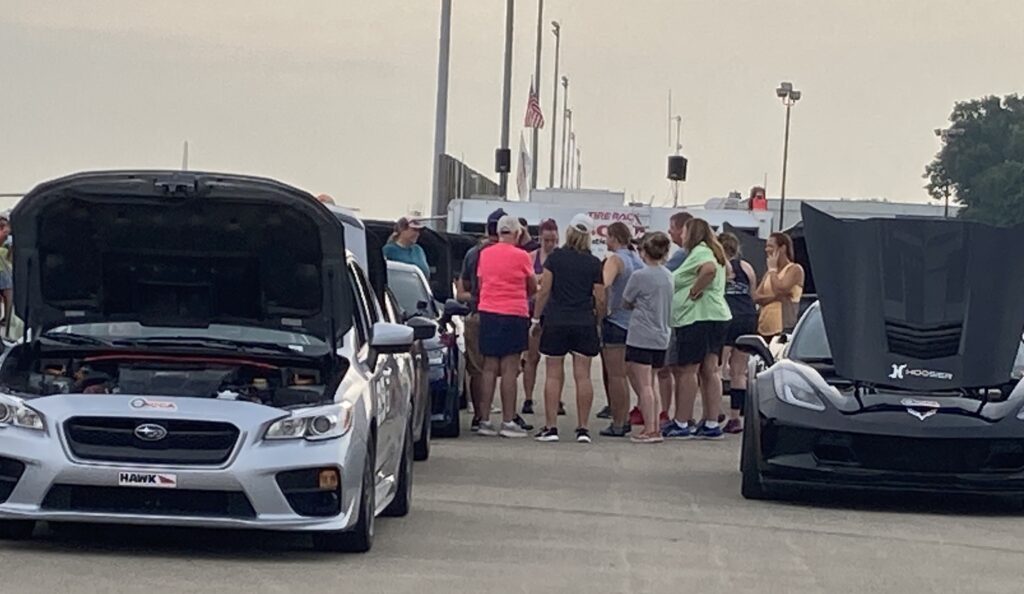
After a winter in which I worked on other things, I restarted the women and autocross project. I had attended some local autocross events last fall, and was able to speak with and interview a few of the women in attendance. The event leaders were very helpful in explaining the basics to me as well as introducing me to some of the female autocrossers. The women I encountered ranged in age as well as experience. One of the older women I spoke with has 11 SCCA National Championships and was the number one female in 2014. Others were just beginning and looked up to the more senior participants for advice and inspiration. While these local events provided a good introduction to the autocross experience, I felt I needed more input from female autocrossers as well as additional observation at autocross events in order to better understand the sport of autocross, particularly as experienced by women.

After completing a number of projects over the winter and spring, I decided to make another attempt at contacting women about their autocross experiences. I was allowed to post a request for project participants on the SCCA Women on Track Facebook page, and was overwhelmed with responses. I am currently in the process of conducting and transcribing interviews with the goal of presenting preliminary findings at the Argetsinger Symposium on International Motor Racing History this November at Watkins Glen International. I also desired to attend autocross events in which there would be a larger number of female participants. That opportunity came on July 24 at the SCCA ProSolo championship series in Toledo, Ohio.
ProSolo differs from the local events I attended not only in the number of participants but also in the way the series is conducted. As noted on the event page, “The TireRack SCCA® ProSolo® Series is an adrenaline-pumping autocross format where solo isn’t solo. Drivers still run a course by themselves, but start off side-by-side drag racing style and attack mirror-image courses to see who gets back to their respective finish lines first.” Drivers get three sets of runs to put together the best run from each side. Class winners participate in the single-elimination rounds on the last day. There is a special Ladies Challenge for the top performing ladies class drivers. Most of the women that day competed in the Ladies classes, while others chose to participate in open.

I arrived Sunday morning in the middle of the ladies competition which was the first event of the day. The ladies runs were preceded by what has become a traditional ‘ladies’ dance.’ Pumping music on the grid before the event begins, dancing provides the opportunity for the women to relax, get loose, and have some fun before getting down to the serious business of competing. It is also a form of bonding, as it helps to make each participant feel like an important part of the group. While I wasn’t able to get close enough to watch the individual runs, I was able to see the women gathered in what is called the ‘impound’ after they finished. There was a lot of chatting, high-fiving, checking out each others’ cars, discussing results, and general camaraderie. I heard a lot of participants – women and men – offering support, with comments like ‘great job’ or ‘you’ll do better next time; it’s all about learning, right?’ There is a lot of waiting around at autocross events – only six minutes of driving over the entire weekend – so socialization is an important component of the experience. Competitors also take the downtime as an opportunity to work on their cars, commiserate with other autocrossers, have something to eat, take a nap, and develop strategies for the next run.
I was able to speak with a few of the competitors after their runs – which included those who made the final round as well as some who experienced car issues and were eliminated. There was a great sense of fellowship among the women in attendance – it is obvious they provide each other with mutual support, team spirit, and fraternity in an endeavor that is overwhelmingly male [at least 90% by my unofficial estimations].

All are required to work at autocross events, and as the women ran in the morning, the afternoon found them in various positions in the booth or on the track. After observing for a bit longer, I headed home, grateful I was able to attend the event and in the process, gain a little more insight into the world of women and autocross.